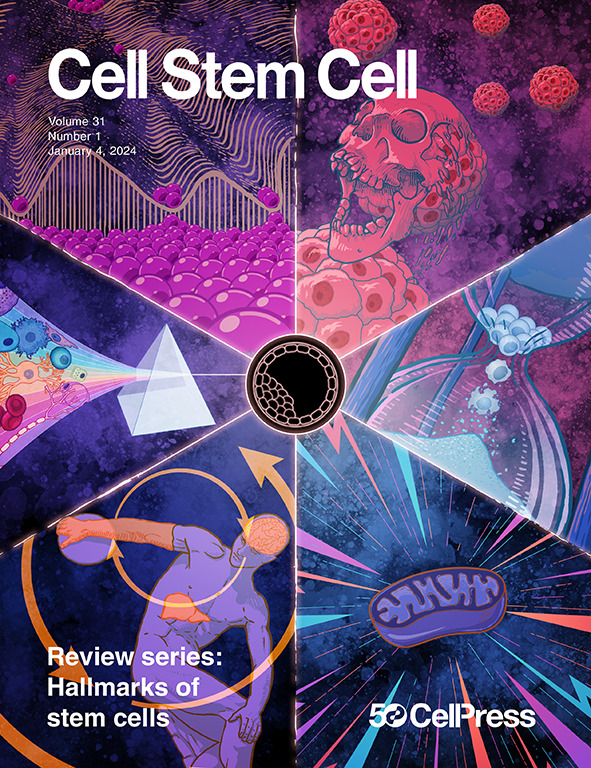在人类 iPSC-心肌细胞中进行 CRISPRi/a 筛选,确定糖酵解激活是多柔比星诱导的心脏毒性的药物靶点
IF 19.8
1区 医学
Q1 CELL & TISSUE ENGINEERING
引用次数: 0
摘要
多柔比星因其危及生命的心血管副作用而限制了其治疗用途。在这里,我们介绍了一个综合药物发现流水线,该流水线结合了人类诱导多能干细胞(iPSC)衍生的心肌细胞(iCMs)、CRISPR干扰和激活(CRISPRi/a)双向集合筛选以及小分子筛选,以确定可减轻多柔比星诱导的心脏毒性(DIC)而不影响其肿瘤学效应的治疗靶点。筛选发现了几个以前未报道过的导致 DIC 的候选基因,包括碳酸酐酶 12(CA12)。基因抑制 CA12 可改善细胞存活率、肌节结构完整性、收缩功能和钙处理,从而保护 iCM 免受 DIC 的影响。CA12 拮抗剂茚地舒兰能有效减轻 iCMs、工程心脏组织和动物模型中的 DIC。从机理上讲,多柔比星诱导的 CA12 可增强心肌细胞中的糖酵解激活,通过干扰细胞代谢和功能导致 DIC。总之,我们的研究为未来的药物发现工作提供了路线图,有可能开发出更有针对性且脱靶毒性最小的疗法。本文章由计算机程序翻译,如有差异,请以英文原文为准。

CRISPRi/a screens in human iPSC-cardiomyocytes identify glycolytic activation as a druggable target for doxorubicin-induced cardiotoxicity
Doxorubicin is limited in its therapeutic utility due to its life-threatening cardiovascular side effects. Here, we present an integrated drug discovery pipeline combining human induced pluripotent stem cell (iPSC)-derived cardiomyocytes (iCMs), CRISPR interference and activation (CRISPRi/a) bidirectional pooled screens, and a small-molecule screening to identify therapeutic targets mitigating doxorubicin-induced cardiotoxicity (DIC) without compromising its oncological effects. The screens revealed several previously unreported candidate genes contributing to DIC, including carbonic anhydrase 12 (CA12). Genetic inhibition of CA12 protected iCMs against DIC by improving cell survival, sarcomere structural integrity, contractile function, and calcium handling. Indisulam, a CA12 antagonist, can effectively attenuate DIC in iCMs, engineered heart tissue, and animal models. Mechanistically, doxorubicin-induced CA12 potentiated a glycolytic activation in cardiomyocytes, contributing to DIC by interfering with cellular metabolism and functions. Collectively, our study provides a roadmap for future drug discovery efforts, potentially leading to more targeted therapies with minimal off-target toxicity.
求助全文
通过发布文献求助,成功后即可免费获取论文全文。
去求助
来源期刊

Cell stem cell
生物-细胞生物学
CiteScore
37.10
自引率
2.50%
发文量
151
审稿时长
42 days
期刊介绍:
Cell Stem Cell is a comprehensive journal covering the entire spectrum of stem cell biology. It encompasses various topics, including embryonic stem cells, pluripotency, germline stem cells, tissue-specific stem cells, differentiation, epigenetics, genomics, cancer stem cells, stem cell niches, disease models, nuclear transfer technology, bioengineering, drug discovery, in vivo imaging, therapeutic applications, regenerative medicine, clinical insights, research policies, ethical considerations, and technical innovations. The journal welcomes studies from any model system providing insights into stem cell biology, with a focus on human stem cells. It publishes research reports of significant importance, along with review and analysis articles covering diverse aspects of stem cell research.
 求助内容:
求助内容: 应助结果提醒方式:
应助结果提醒方式:


